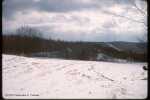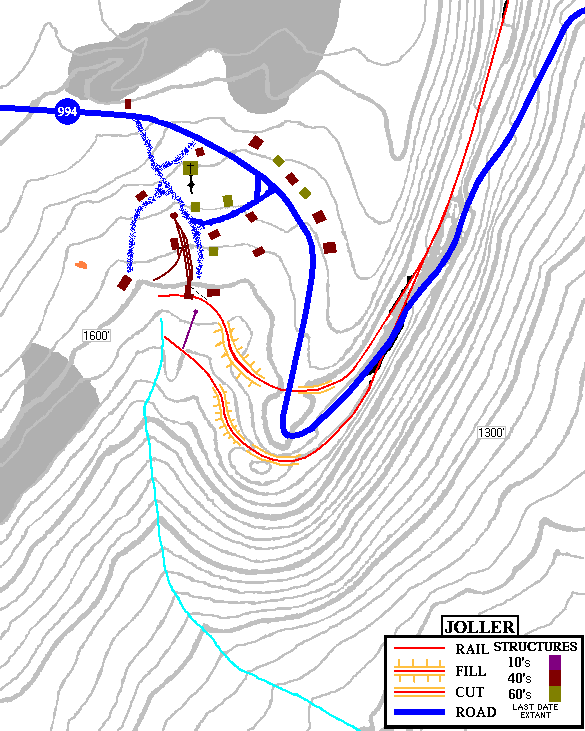

Mile Mark: unknown
Elevation: unknown
Date Built: 1915
Published Photos: EBT 109
Published Plans: EBT 116
Joller sets inside a nook of Wrays Hill, facing south. As an extension of Broad Top Mountain, Wrays Hill also contained commercial quantities of semi-bituminous coal, though not in as great of quantities. A previous mine had tapped the opposite side of the hill about half a mile to the north, but that was a much smaller operation. The Midvalley Mine opened in either late 1915 or 1916 under the ownership of John H. Miller and Henry Knepp, two men involved in logging operations on that land.
The original Coles Valley Branch was built in 1916 and served a frame tipple mining the upper Barnett Seam via a drift mine. It was unusually steep when compared to the EBT main and incorporated many tight curves and wood trestles. A cut was made at the point the branch crested and descended slightly to the mine's nook. In 1919 a new branch was built to service a slope mine on the lower Fulton Seam. At this time the town was officially renamed Joller, a concoction of the US Postal Service from JOhn miLLER. The name ended confusion with two other Midvalleys in Pennsylvania. When a new branch alignment was built to service the new tipple, a new cut and trestle were needed. It split from the previous alignment a few hundred feet before its crest. All the trestles on the branch were, in time, filled in with mine rubble and furnace slag, as well as rubble from the old furnace buildings at Rockhill. When both tipples burned in 1937 a new steel one was constructed on the site of the upper tipple. It serviced the Fulton Seam via a shaft (same galleries as before) and the drift mine into the Barnett seam. The lower line was likely abandoned at that time. Underground operation, under various incarnations, continued until 1966 totaling about 1,266,397 tons. The EBT serviced the mine until 1948, when trucks, which had been servicing the mine since 1932, took over. The branch remained in place until 1955, when it was dismantled.
Sometime after 1966 the tipple was removed down to its foundation. Some residents remained until 1979 when, in preparation for strip mining operations, the remaining structures were leveled. Small amounts of stripping were done as Rockhill Coal Mine No. 15 in the 1950's, but nothing came of this attempt. Later the area became state hunting lands. The shaft to the lower galleries was filled in and the upper drift bore collapsed for several hundred feet back from the entrance. It produced copious amounts of water that percolated through the entire site. Next to the old lower tipple site, the old tramway, lined with random stone walls remained in place.
In 1998 Joller underwent mine reclamation. The town foundations were mostly unmolested but the upper drift mine opening, tipple foundation and old tipple tramway have all been erased.
Joller is on PA 994 on top of Wrays Hill just west of the hairpin turn. It can be accessed via the upper EBT branch or from the hunting lands parking area on the south side of the road. Numerous foundations in the area show the locations of the dozen or so buildings, most within a short distance of the parking area on either side of the entrance road and PA 994. Further down the access road, the lower mine and lower and upper tipple sites have been obliterated by the mine reclamation project. Five settling ponds now harness the runoff from the upper mine and sequentially allow the contaminants to settle out before release to the next pond. The lower EBT grade has been converted to the lower retaining wall for the lowermost settling pond. The mine tailings pile is still present at the lower grade and marks the point where the old tramway met the lower line. A small clump of four trees at the level of the upper line marks the location of the last tipple and shaft.
West of the tipple site the upper grade is reasonably open and hikeable across the fill and PA 994 and through the cut to the switch point. The switch point is about 200 yards from the hairpin turn. The lower line fill and cut are more overgrown, but passable by the determined hiker. The lower line disappears below PA 994 at a point where it is lined by a stone retaining wall. The lower line emerges several feet above the road and is effectively made unhikeable from the road to the switch point because of thick tough brush. West of the tipple site the mule barn now has a construction road bulldozed through its center, though relics of the building's purpose still abound. The Martin Mine, further northwest, does not seem to have been affected by the work.
See an aerial photo of Joller.

Back to Coles Valley Branch Split |
Click on an image to see larger version
|
Forward to RI&C Mine No. 15 |
||
|---|---|---|---|---|
| Up to Coles Valley Branch | ||||
| Tour Entry | Tour Index | Tour Info | ||